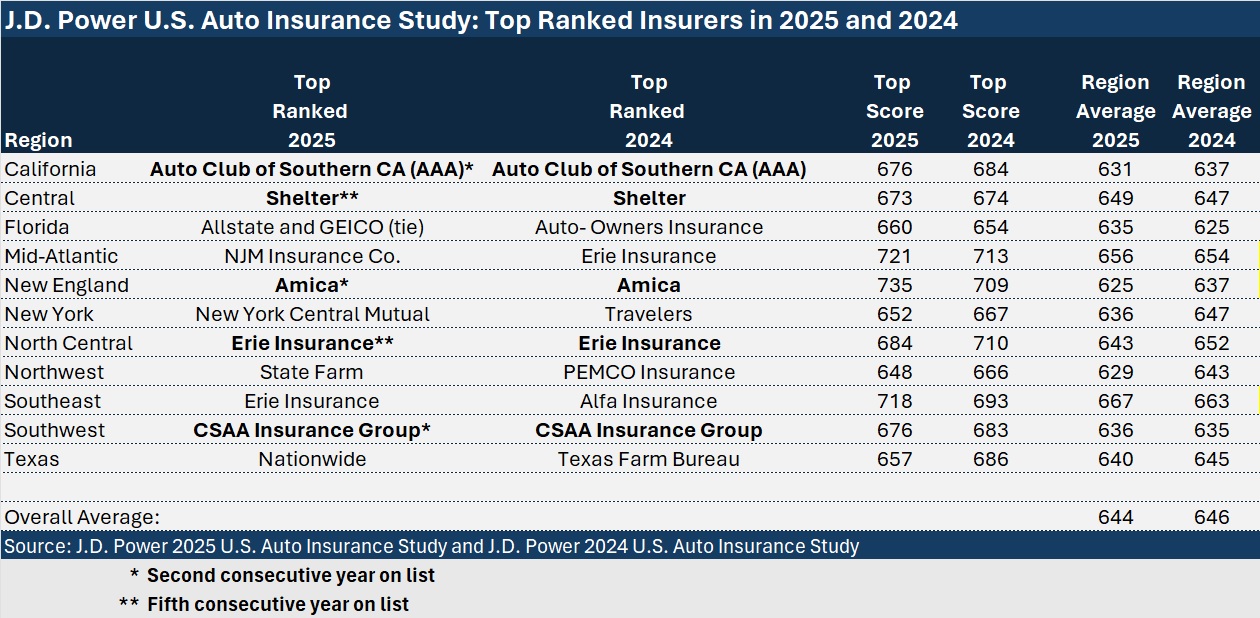It’s Now a Buyer’s Market for Auto Insurance, J.D. Power Finds.
The headline atop the announcement for the J.D. Power 2025 U.S. Auto Insurance Study, released this week, captured a crucial insight from over 48,000 auto insurance customers surveyed across 11 regions between May 2024 and April 2025: an increasing number of policyholders are contemplating not renewing their coverage with their current insurers.
This trend is particularly pronounced among customers with higher overall lifetime value—defined by J.D. Power as those paying higher annual premiums, maintaining long-term relationships, and holding multiple policies with their current insurers. While just over half (51%) of these high-value customers say they “definitely will” renew their policies, this figure is actually lower than the renewal intentions of medium-value customers (53%) and low-value customers (54%).
Now that insurers are writing at profitable levels and “shifting back into [policy] growth mode, they really need to focus on cultivating and keeping high-value customers,” said Stephen Crewdson, managing director of insurance business intelligence at J.D. Power, in a media statement about the latest study.
Among many of those customers, “overall satisfaction this year is not particularly high. To shift that perception after the past few years of significant rate increases, insurers need to focus on delivering a tailored, seamless customer experience across all channels,” Crewdson said.
Overall customer satisfaction with auto insurers dipped slightly by 2 points, dropping from 646 to 644 on a 1,000-point scale compared to last year. However, J.D. Power highlights that over one-third of customers—38%—fell into the lowest tier of satisfaction scores. Customers in this segment are significantly less likely to renew their policies with their current insurers, according to J.D. Power.
Like previous years, the latest study provides rankings of insurance companies according to their satisfaction scores across 11 regions. Below, Carrier Management has compiled a summary of the top-performing insurers for 2025 and 2024, along with their scores compared to the regional averages where they secured first place.

Consistent with previous rankings, smaller insurers—operating in fewer than half the states, and some limited to just one state—continued to dominate the top positions in the 2025 listings. Only five national insurers earned the No. 1 rank in any region, with Allstate and GEICO tying for the top spot in Florida among them.
The highest-ranked national insurer—and indeed the top-ranked insurer across all regions in the study—was Amica, which secured first place in New England for the second consecutive year, achieving a satisfaction score of 735 this year.
Regional insurer NJM Insurance and Erie Insurance, which operates in roughly a dozen states, both exceeded the study average of 644 by more than 70 points—NJM earning a score of 721 in the Mid-Atlantic region, and Erie achieving 718 in the Southeast.
Erie stands out as the top-ranked insurer in two regions—North Central and the Southeast—while placing a close second to NJM in the Mid-Atlantic region, where it scored 706.
Erie and Shelter are the only insurers to hold the No. 1 satisfaction ranking in a single region for five consecutive years—Erie in the North Central region and Shelter in the Central region.
Now in its 26th year, the U.S. Auto Insurance Study evaluates customer satisfaction with auto insurers by assessing performance across seven key dimensions, rated on a scale from poor to perfect. The dimensions, listed in order of importance, are:
- Level of trust
- Price for coverage
- People
- Ease of doing business
- Product/coverage offerings
- Problem resolution
- Digital channels
Commenting on the different satisfaction metrics, J.D. Power emphasized that a seamless experience across all service channels is the strongest driver of overall satisfaction among auto insurance customers. “When insurers deliver on this key performance indicator, customers are significantly more likely to have higher levels of trust in their insurer; feel better about the people they are working with; and feel like it is easy to work with their insurer.”
The J.D. Power report summary also highlighted that, although customers identified competitive rates as the primary reason for choosing an insurer, exceptional service and a positive claims experience were the key factors driving client retention, according to the survey findings.
Due to the implementation of a new rating scale, satisfaction scores from 2023 and earlier are elevated and cannot be directly compared to those from 2024 and 2025.
For more explanation of the changes, see the related article, “J.D. Power UBI Scores vs. Overall 2024 U.S. Auto Insurance Satisfaction Scores”
The J.D. Power 2025 U.S. Auto Insurance Study also features a ranking of usage-based insurers, with Nationwide earning the highest score (698 in 2025) for the second year in a row.”

Last year, a J.D. Power representative explained to CM that the UBI scores are determined by the following factors:
- Initial program setup/onboarding (for drivers that signed up for UBI within the past year)
- Ease of participating in the program
- Usefulness of the information received
- Functionality of the app/website
- Discounts received for participation
Unlike the overall satisfaction scores, the scoring scale for UBI satisfaction remained on a 10-point scale until this year, when it shifted to a 6-point scale. As a result, the 2024 UBI satisfaction scores are not directly comparable to those in the current report. (For instance, Nationwide received a score of 842 last year.)
Source: insurancejournal






































